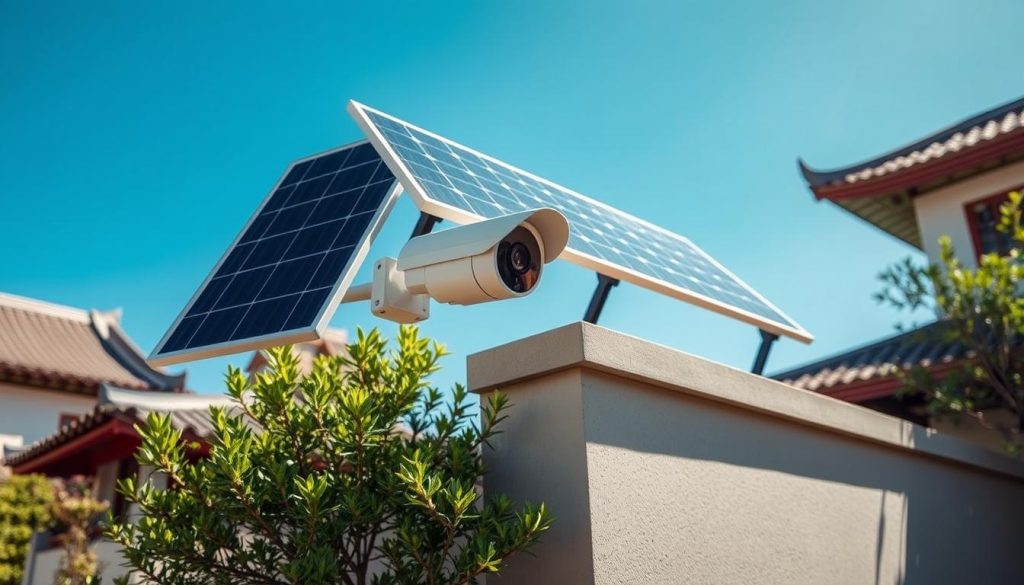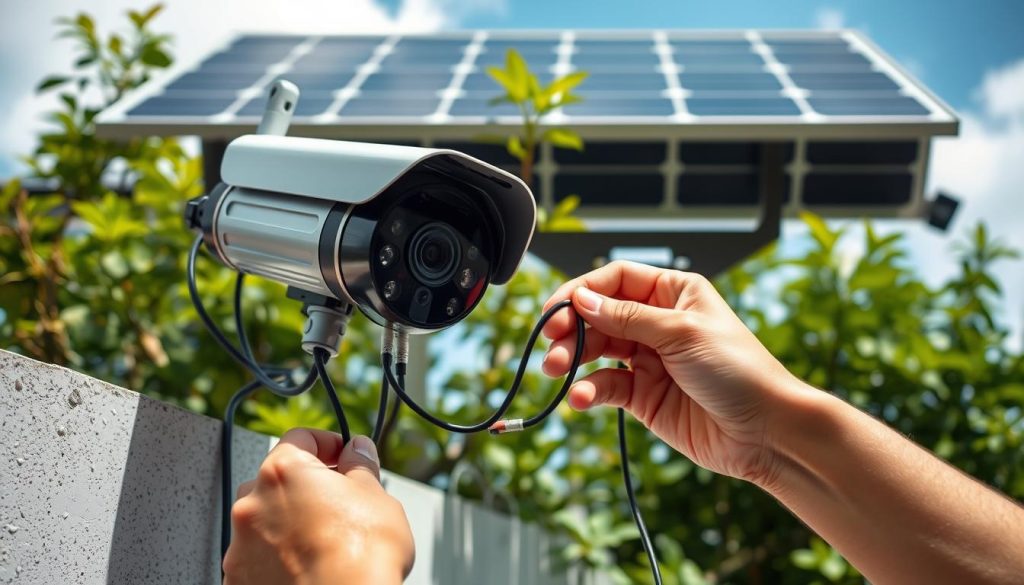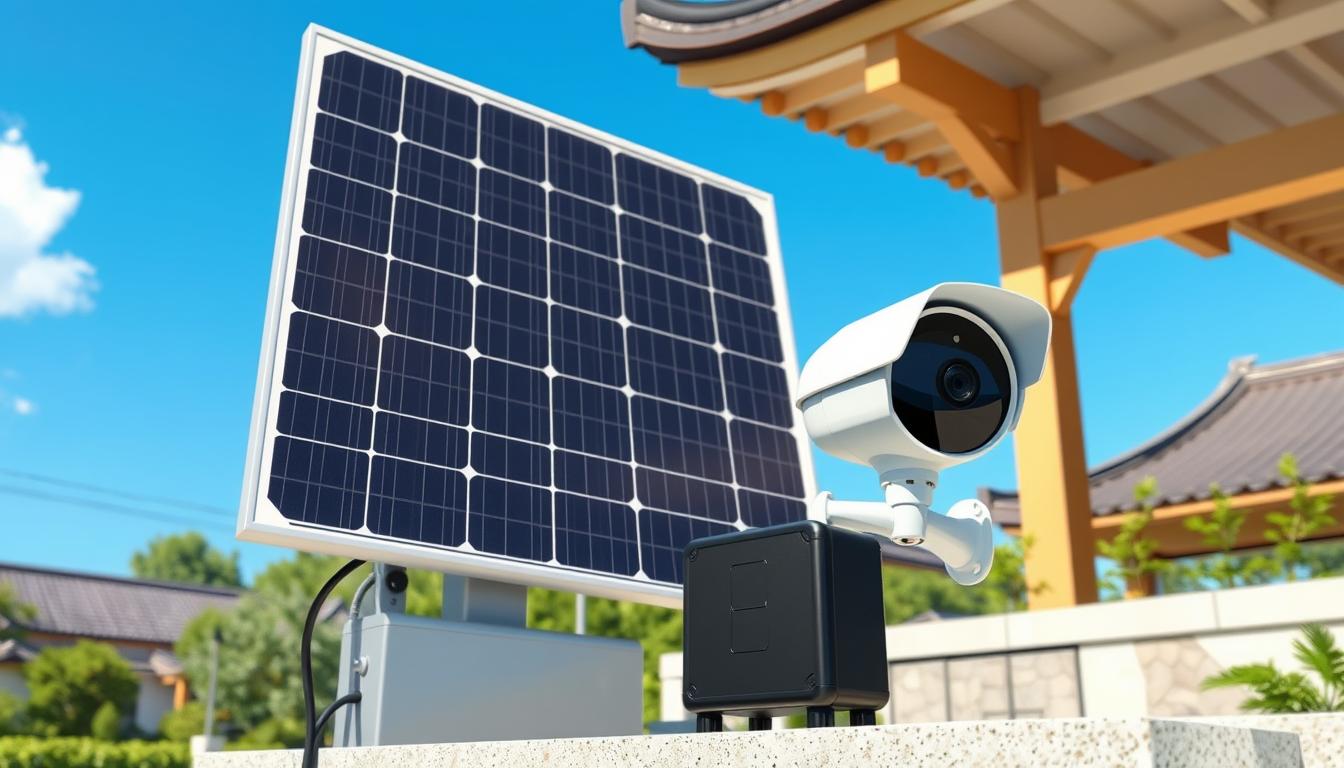Solar Panel with Battery for Security Camera Guide
Home security is more important than ever. Using a solar panel with a battery for security cameras is a smart choice. It cuts down on the need for traditional power and helps the environment.
With solar powered security cameras, you save money and keep your home safe. This guide will help you understand the benefits and how to set up outdoor solar camera systems. If you want more info or the latest CCTV solutions, call Wen Hong at +65 6013 5960.
Key Takeaways
- Solar camera systems offer sustainable and cost-effective security solutions.
- Placement and tilt angle of solar panels are key for best results.
- Tapo Solar Panels work with many camera models, giving you options.
- Battery life for solar security cameras varies a lot, depending on use.
- These systems work even on cloudy days, but not as well.
- Getting updates keeps your system running smoothly and improving.
Introduction to Solar-Powered Security Cameras
Solar-powered security cameras are a big step forward in surveillance tech. They use sunlight to make electricity. This means you can put them in places where it’s hard to get power, like cities and rural areas.
These cameras are good for the planet too. They work with a battery backup, so they keep going even when it’s dark. Places like Phoenix and Las Vegas get a lot of sun, making these cameras work well. But in cloudy places like Anchorage and Seattle, they might not work as well.
Getting solar cameras can cost more than wired ones at first. But, you save money on electricity over time. You’ll need to replace batteries sometimes, which can add to the cost. Also, features like night vision might not work as well when it’s not sunny.
How well a solar camera works can depend on the weather. You need to watch out for humidity and temperature. Also, if the sun changes with the seasons, you’ll need to make sure the battery is strong enough all year.
As more people use solar cameras, it’s important to know their pros and cons. They can really help with keeping an eye on things, if you choose the right ones for your area.
Benefits of Using a Solar Panel with Battery for Security Cameras
Using a battery operated solar security camera has many benefits. It’s great for those who need reliable surveillance without the usual electrical setup. A solar panel security camera doesn’t need a lot of infrastructure, saving on labor and setup time.
These cameras work well in places without a steady power supply. A wireless solar security camera uses cellular connectivity, not Wi-Fi. This makes them perfect for farms, construction sites, or outdoor events.
These systems come with a solar panel that can charge multiple batteries. This means they keep working even at night or in bad weather. Plus, solar energy works well in winter, making them reliable all year.
Using solar power also helps the environment. It cuts down on fossil fuel use, making businesses more sustainable. Solar cameras save money on energy and don’t need professional installers.
Features like motion detection and night vision make these cameras useful in many places. They’re weatherproof too. In short, solar security cameras are a smart, cost-effective, and green choice for keeping things safe.
Components Required for Setting Up a Solar Camera System
Setting up a solar powered outdoor surveillance camera system needs several key parts. Each part is vital for the system to work well and keep your place safe.
- Solar Panel: This is the system’s core, turning sunlight into energy. A 75W rating is best for daily needs.
- Battery: It stores energy, and a 24Ah capacity is good for constant use. This ensures power when needed.
- Solar Charge Controller: It manages the energy flow from panels to battery. A 10A/12V rating is ideal.
- Security Camera: Choose a top-notch camera like the Reolink RLC-410W. It captures clear images and connects via Wi-Fi or LTE.
- Connecting Cables: Good cabling links parts well. A 14 AWG cable works best for up to 10 feet to avoid energy loss.
- Crimp Connectors: They securely connect cables, making energy transfer smooth.
- Battery Enclosure: It guards the battery from the environment. This keeps it working well for a long time.
With these parts, you can build a strong off grid security camera system. It works on its own, without needing regular power. This means you get reliable watch even in hard-to-reach or unstable places.
Power Requirements for Your Solar Security Camera
Knowing how much power your solar security camera needs is key for it to work well. Most solar cameras use between 4 to 15 Watts. For example, a camera that uses less than 10 watts can work well with a solar panel with battery for security camera system. This includes a 12V battery setup, making sure it runs smoothly.
To figure out how much power you need, look at your camera’s specs. For instance, the TP-Link camera uses 5.4 Watts. It needs about 43.2 Watt-hours (Wh) if it’s on for 8 hours a day. On the other hand, the Google Nest Cam IQ uses 13 Watts and needs about 104 Wh for the same time. Picking the right battery size depends on how much watt-hours your system needs.
Here’s a breakdown of power consumption for various popular security cameras:
| Camera Model | Power Consumption (Watts) | Daily Usage (Wh at 8 hours) |
|---|---|---|
| TP-Link Camera | 5.4 | 43.2 |
| Google Nest Cam IQ | 13 | 104 |
| Vivint Outdoor Camera | 7 | 56 |
| Ring Floodlight Cam | 15 | 120 |
For best performance on cloudy days or when sunlight is low, you might need a bigger solar setup. For example, the Jackery Solar Generator 1000 Pro can power a typical security camera for about 85.2 hours when fully charged. Using this generator with the TP-Link camera can extend its use to about 157.7 hours. This shows how effective a strong solar solution can be.
A well-made solar panel system can give you the power you need efficiently. It also makes sure your security system lasts a long time. For more tips on setting up a complete system, check out this guide.

Understanding Solar Panel Ratings and Selection
When you set up a solar powered security camera system, the solar panel’s efficiency is key. The rating of a solar panel shows how much power it can make in perfect conditions. Panels with higher ratings usually collect more energy and work better.
Several things affect how well a solar powered security camera system works. Important things to think about include:
- Local sunlight conditions
- Peak sunlight hours
- Potential energy losses
Knowing these helps pick the right solar panels. For example, if your CCTV system uses 63.4W, you need solar panels that can handle that. If a PoE+ system can use up to 120W, you need panels that can keep up.
Also, think about how you’ll store energy. Batteries like Lithium or Lithium-Ion have different lifespans. Lead Acid Batteries last about 600 cycles, while MnNiCo Ternary Lithium Batteries last around 800 cycles. LiFePO4 Lithium Batteries can last up to 5000 cycles.
For places where power is not always reliable, it’s important to look at solar panel ratings and battery choices. Learning about these components helps make a system that works well on its own, even when energy needs change.
Choosing the Right Battery for Your Solar Camera Setup
Choosing the right battery for your solar camera is key. It affects how well it works and lasts. Knowing what to look for is important to keep it running smoothly when it’s dark.
- Battery Types: You have Lead Acid and Li-Ion batteries. Lead Acid is cheaper but needs more care. Li-Ion costs more but lasts longer and works better.
- Capacity Sizing: The battery’s power should match your camera’s needs. A good rule is to have a battery that’s ten times the solar panel’s power to avoid overcharging.
- Cycling Recommendations: Running batteries at 50% helps them last longer. This makes your solar security system more reliable.
- Weatherproof Enclosures: Keep batteries in weatherproof cases rated IP66 or better. This protects them from the weather.
Choosing the right battery for your solar camera involves several steps. You need to think about the battery type, its power, and how it’s protected. This ensures your solar camera works well and keeps you safe.
| Battery Type | Advantages | Disadvantages |
|---|---|---|
| Lead Acid | Lower cost, widely available | Heavier, shorter lifespan, less efficient |
| Li-Ion | Longer lifecycle, lightweight, efficient | Higher initial cost |
Installation Process of Solar Panel with Battery for Security Camera
Setting up a solar panel security camera needs careful planning. Each step is key to making your solar cameras work well. First, pick a spot that gets 6-8 hours of direct sunlight a day. This makes sure your camera has enough power to work right.
- Choose the location: Find a place with clear sunlight.
- Mark the mounting points: Use a level to place marks evenly before drilling screw holes.
- Prepare for mounting: For masonry, use plastic anchors and a hammer. For wood or vinyl, just use screws.
- Attach the panel: Fix the solar panel to the mounting plate. You can adjust the angle to catch more sunlight.
- Connect the camera: Connect all wires carefully. This is important for the camera and solar panel to work well together.
- Weatherproofing: Take off the weatherproofing plug and make sure it’s sealed again after setup.
- Monitor battery charge: Keep an eye on how much power you’re making. It can change with the weather and seasons.
- Final adjustments: Check all connections and make sure the camera is in the best spot for watching.
A good solar panel can make 250-350 watts of power when it’s sunny. This is enough for several battery-powered cameras. Doing these steps right helps avoid problems like less power because of blockages or bad angles. Knowing these steps will make your surveillance system last longer and work better.
Wiring and Connecting Your Solar Security Camera
Proper wiring is key for a solar security camera system’s efficiency. Wiring solar powered security camera systems means linking important parts for the best performance.
Start by linking the solar panel to a solar charge controller. This controller is essential for managing energy from the panel to the battery and camera. Using quality cables helps keep energy loss low, boosting performance.
When connecting solar camera to battery, make sure all parts fit together well. The Tapo solar panel, for example, is weatherproof, fitting well outdoors. Here are some steps for easy installation:
- Place the solar panel where it gets the most sunlight, aiming for a tilt of 35° to 45°.
- Use at least three screws and anchors to keep the solar panel stable.
- Link the solar panel to the camera safely.
Different cameras need different connections. For example, the Tapo C425, C420, and TC85 use Micro USB ports. Make sure all parts work together without problems.
The table below shows key specs for Tapo cameras and their solar panel compatibility:
| Camera Model | Micro USB Compatible | Recommended Battery Voltage |
|---|---|---|
| Tapo C410 | No | 12V |
| Tapo C425 V1.0/V1.20 | Yes | 12V |
| Tapo C420 V1.0/V1.20 | Yes | 12V |
| TC85 V1.0/V1.20 | Yes | 12V |
| Tapo C400 | No | 12V |
Keep your solar panel clean to improve charging. Adjust your setup based on the weather to keep everything working well. With the right setup, your solar security camera will work great.

Maintaining Your Solar-Powered Security System
Solar-powered security cameras are becoming more popular. They’re great for places that are hard to wire. Keeping your system in top shape is key to its performance and life span.
Clean the solar panels every few months. Dust and dirt can block sunlight. Also, check the battery health regularly. Brands like LS VISION make it easy to replace batteries, so you don’t have to replace the whole camera.
Test your camera’s video quality, motion detection, and connectivity every few months. This helps catch problems early. LS VISION cameras are built to last, with weatherproof casings. But, be careful in very hot or cold weather to keep them working well.
Winter can be tough on solar-powered systems. Less daylight and snow can reduce how well they work. Keeping batteries charged is important, and insulated batteries help in extreme temperatures.
Here’s a checklist to help you maintain your solar security cameras:
- Clean solar panels every few months
- Check battery health regularly
- Test video quality, motion detection, and connectivity quarterly
- Inspect camera placement and shelter from elements
- Monitor software and firmware updates
- Ensure proper sealing of electrical lines to reduce overheating risks
By following these tips, you can keep your solar security system running smoothly. These simple steps help keep your home or business safe and secure.
| Maintenance Task | Frequency | Purpose |
|---|---|---|
| Clean solar panels | Every 3 months | Maximize sunlight absorption |
| Check battery health | Monthly | Ensure optimal performance |
| Test functionality | Every 3 months | Avoid missing important footage |
| Inspect camera placement | Seasonally | Prevent environmental damage |
| Monitor software updates | Monthly | Maintain security and performance |
Real-Life Applications of Solar Powered Security Cameras
Solar-powered surveillance cameras are becoming more popular in many areas. They are great for places where it’s hard to get power. This makes them perfect for keeping an eye on homes in remote spots.
Models like the HeimVision HMD2 are easy to set up. They also give high-quality video, which is key for good surveillance.
These cameras are not just for rural areas. They’re also useful in cities, at outdoor events, and on construction sites. They can be moved easily, which is great for places where security needs change a lot.
After natural disasters, solar cameras help keep areas safe. This is because they don’t need electricity or cables.
Businesses are also using these cameras. They work well even when it’s cloudy. This means they can save money on power and avoid monthly fees. Solar cameras are becoming a top choice for keeping places safe and secure.
FAQ
What is a solar-powered security camera with a battery?
How does a solar panel security camera work?
What are the benefits of using an outdoor solar camera system?
Can I use these cameras in remote locations?
How do I determine the right solar panel and battery for my camera?
What should I consider when installing a solar powered security camera system?
Is maintenance required for solar powered security cameras?
Are solar surveillance cameras adaptable to extreme weather conditions?
How do I connect my solar security camera to the battery and solar panel?
What types of batteries work best for solar-powered security cameras?
Source Links
- https://www.tapo.com/sg/faq/587/
- https://www.tapo.com/en/news/429/
- https://www.deepsentinel.com/blogs/home-security/solar-powered-security-cameras/?srsltid=AfmBOopnL1RK8qJIoH4DxErJERnePTXBx43QjKQZOvszgIJVzdS4fkLd
- https://www.lsvisionsolar.com/an-overview-of-solar-powered-cctv-cameras-and-working-environment/
- https://www.lvt.com/blog/7-advantages-of-installing-a-solar-powered-security-system
- https://trueview.co.in/advantages-of-cctv-cameras-with-solar-panels/
- https://ucocare.net/blogs/blog/the-pros-and-cons-of-solar-security-cameras
- https://www.instructables.com/How-to-Solar-Power-Your-Home-Security-Camera/
- https://www.lsvisionhd.com/how-to-install-solar-cctv-camera/
- https://optraffic.com/blog/solar-tower-with-cctv-camera/
- https://ca.jackery.com/blogs/news/solar-powered-security-camera?srsltid=AfmBOoqnacLsmox3Rz24dMtTtflkrE_pk76X-5YZ7hxfvbYD8Aue-8Xl
- https://loyalty-secu.com/products/solar-powered-kits-for-any-security-camera-200w-60ah/
- https://www.linkedin.com/pulse/solar-panels-security-cameras-buyers-guide-d5ehf
- https://edgewaretech.com/how-to-calculate-solar-panel-and-battery-for-cctv-system/.html
- https://www.lsvisionsolar.com/the-difference-between-traditional-ipc-cameras-and-solar-cameras/
- https://www.lsvisionhd.com/how-to-choose-a-suitable-solar-camera/
- https://www.lsvisionsolar.com/what-to-consider-when-buying-a-solar-security-camera/
- https://support.reolink.com/hc/en-us/articles/360003493294-How-to-Install-Reolink-Solar-Panel/
- https://ring.com/au/en/support/articles/g2q8r/Physically-Installing-Spotlight-Cam-Solar-Panel?srsltid=AfmBOoooxSosLLd-9PgBoOGDtPOC9MGecwT68miPCeNndfw9Epa4b4PJ
- https://www.kentfaith.co.uk/blog/article_how-to-install-solar-camera_1794?srsltid=AfmBOooM6ikdxG8Px1M8UYNRRIt4G3YYxJD1M6ZPYU0MtDDeiOD-KkBh
- https://www.tp-link.com/sg/support/faq/3827/
- https://reolink.com/blog/solar-power-wireless-security-cameras/?srsltid=AfmBOopjnVATcjliF0Xg8IMlB4xgPC_XD4X7Jkza65T7wutR-LPQ7c88
- https://www.lsvisionhd.com/maximize-solar-camera-usage-and-maintenance-with-expert-tips/
- https://anran-cctv.com/blogs/news/winter-solar-security-camera-care?srsltid=AfmBOoqS4ea1MAHJsmCg-vtEuJiDXNtzuexPByM1gzG-xN8Y5lrjSad1
- https://reolink.com/blog/solar-power-wireless-security-cameras/?srsltid=AfmBOor-yhpAcqz_mxcUV9qXt6QjozcN7UB6MGA7eRxqfADK5WqsvyWR
- https://www.lsvisionsolar.com/why-use-4g-and-wifi-solar-powered-security-camera/
- https://www.heimvision.com/blogs/news/battery-powered-security-camera





